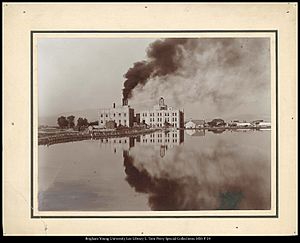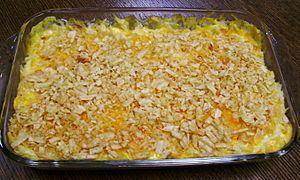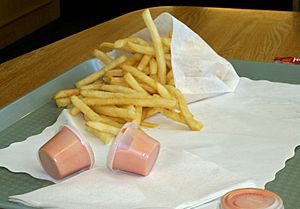Mormon foodways facts for kids
Mormon foodways are the special ways of eating and drinking that are part of the religious and social life of members of The Church of Jesus Christ of Latter-day Saints, often called Mormons. A set of health guidelines called the Word of Wisdom tells Mormons not to drink alcohol, coffee, or tea. These rules became more strictly followed in the 1900s. Also, members are usually encouraged to skip two meals on the first Sunday of each month, which is called Fast Sunday.
Long ago, in a place called Nauvoo, Illinois, Mormon food was much like what other people ate on the frontier. Later, when Mormons moved west, their food habits became different from miners and other groups. Mormons used food they grew, food they found in nature, and cooking ideas from their homes in New England and Europe. Early Mormon settlers, called "pioneers," used spices and tried to grow special kinds of fruit, like apples and peaches, that would grow well in the new land. They learned from local Native American tribes what plants were safe to eat when food was scarce. Pioneers also made their own sweeteners. They dried or canned fruit to save it for later. Bread was a common food, and they worked together to butcher meat, which they preserved by smoking. Many pioneers came from Europe and brought their food traditions, like making cheese and sauerkraut.
Today, Mormons often share recipes to help them use up their stored food, which can include processed items. Food in areas where many Mormons live, like Idaho, Utah, and Arizona, is similar to comforting Midwest food. Some dishes, like Utah scones and funeral potatoes, are special to Utah. As the church grows around the world, there isn't one type of food that all members eat. However, food is still an important part of church gatherings, like ward dinners.
Contents
Understanding Dietary Guidelines
A scripture called Section 89 of the Doctrine and Covenants, known as the "Word of Wisdom," gives members rules about food. It suggests eating fruit when it's in season, eating meat only a little, and eating grains, especially wheat, which is called "the staff of life." This scripture also says not to use alcohol, tobacco, or "hot drinks" (like coffee and tea). These rules were not always followed strictly until the 1900s. By 1921, following these rules became necessary to enter a temple. In the late 1800s, some pioneers drank coffee, tea, and even whiskey. They also grew herbs like peppermint and jasmine for herbal teas. Avoiding coffee and tea helps Mormons feel like a strong group and can offer health benefits.
Fasting and Helping Others
The first Sunday of every month is set aside for fasting. This means not eating or drinking for two meals. Members often give the money they would have spent on those meals as a "fast offering." This money helps feed people in need in their local area. Local church leaders, called bishops, use these funds to provide food to poor people through a special place called a bishop's storehouse. Young children and people with health problems usually do not fast.
Sacrament Bread Traditions
In the early days, women baked bread for the sacrament service. This happened in Kirtland, Ohio, and later in Utah in the 1890s. One woman would carefully cut the crusts off the sacrament bread. She would carry it on a special crystal plate, making her own special tradition. Pioneers often ate bread for their meals. Sometimes they softened it with molasses. They also made soup using dried bread.
Pioneer Food in Illinois
Mormon food in Illinois was much like what other settlers ate on the frontier. Most people in Nauvoo could not afford modern cookstoves. Instead, they used "spiders," which were like Dutch ovens. Since many pioneers came from the northeastern United States, they called them "bake ovens." These bake ovens allowed settlers to make bread without a regular oven. Some people switched to stove cooking when they could, while others kept using bake ovens.
Settlers in Nauvoo grew many crops. These included apples, cucumbers, corn, grapes, melons, oats, peaches, potatoes, pumpkins, rice, squash, tomatoes, and wheat. When the snow melted, women made maple syrup. They enjoyed fresh vegetables in the summer. Women also made pickles and dried fruit to save for later. Vegetables were expensive to buy, but meat was cheaper. If a family had a cow, the woman of the house or a child would milk it.
Pioneer Food in Utah
What Pioneers Ate and Grew
Pioneers used old types of crops and farm animals. The very first crop planted in the Salt Lake Valley in 1847 was potatoes. After that came buckwheat, corn, oats, turnips, and beans. Peach pits and apple seeds were planted soon after. Some pioneers brought seeds from other places, like a type of wheat and a pea from California. Onions were grown a lot, but not garlic. Nutmeg was very popular, and spices like cardamom, cinnamon, cloves, and black pepper were also used. Farmers worked hard to grow types of apples, peaches, and pears that would do well in Utah's weather.
Farm animals were used for many things. Shorthorn cattle pulled wagons and plows, and also gave milk and beef. A popular type of sheep called Spanish Churro was used for both wool and meat. Later, more specialized animals were used. Lard, a type of fat, was hard to make but very valuable.
Wheat flour was scarce, so many pioneers used corn flour instead. Corn was cheaper and easier to grow than wheat. Early mills, powered by water, made different kinds of flour, from whole-wheat to white flour. Corn was easier to grow on new land, and everyone ate corn dishes like Hominy. Poor families would gather leftover wheat from fields.
In 1847, pioneers learned about local wild foods from Native American tribes like the Goshutes. Pioneers ate wild sego bulbs, rose hips, berries, onions, and wild greens like dandelions. They hunted animals like elk, rabbit, duck, and fished for trout and salmon. When grasshoppers destroyed crops in 1855, pioneers fished and stored millet and trout for winter. They gathered wild berries like service berries, chokecherries, currants, raspberries, strawberries, and elderberries. How much food they could gather depended on rain and grasshopper problems. In years with bad harvests, pioneers survived on what they could find in nature. Spring foods included peas and radishes. Summer brought lettuce, beans, and corn. In the fall, they ate tomatoes, cabbages, carrots, and potatoes.
Early church leaders encouraged pioneers to make their own sweeteners. They wanted to keep money in the Utah Territory instead of buying sugar from outside. Pioneers were encouraged to plant sorghum cane and sugar beets. They processed these into molasses. Molasses was the main way to sweeten food until a sugar beet factory was built in Lehi in 1890. Some pioneers even tried to get sweet sap from box elder trees, similar to maple syrup. They also used sweet ingredients like squash and berries to sweeten their cakes. Pioneers often had watermelon feasts to celebrate special times.
Starting in 1853, pioneers could buy yeast for baking from a bakery in Salt Lake City. Sometimes, one family would grow yeast and share it with others in exchange for flour or sugar. Making cider was common for people from New England, and it also produced yeast. Pioneers also used sourdough starters for bread. They made vinegar from pea shells or grapes.
How Pioneers Prepared Food
Pioneers canned and dried fruit, saving enough to last for two years. They stored preserved food in cellars and ate it during the winter. They dried large amounts of fruit. One pioneer wrote about inviting young people to a "cutting bee" to prepare fruit for drying. They traded dried fruit for flour or other items. In the 1860s, the church helped sell dried fruit. They bought it from farmers or accepted it as a donation, then sold it to miners. Miners in Montana bought 200,000 pounds of dried fruit in 1864. This export helped Utah's economy. Pioneers also dried squash, pumpkin, and melon. If they didn't have apples, they made squash butter, which was a spreadable form of squash. They also preserved fruit in molasses syrup. When glass Mason jars became common in the 1860s, women in Utah used them to preserve fruit.
Bones from pioneers show they had decayed teeth. This might be because they ate a lot of starchy foods. Most pioneers who came from the United Kingdom continued to eat bread and potatoes, which were popular there. Wheat flour was the heaviest item in wagons traveling west. They used a type of baking powder called saleratus to make their bread rise. Recipes from that time assumed bakers already knew how to make bread. Church leaders encouraged pioneers to save meat for winter and eat fish and eggs in the summer. Pigs were usually ready to be butchered in December.
To save meat, pioneers salted and dried fish in large amounts. One pioneer woman used salt from the Great Salt Lake to preserve her beef. Neighbors often helped butcher a pig for winter. They made ham, bacon, and sausage from the pig. In some places, neighbors would get a small amount of fresh meat as a tradition. Pioneers also smoked their own meat in a smokehouse or chimney. They used natural ways to make sauerkraut and cheese. Dairy products were often traded. A Jersey cow could produce more milk than a family needed, so extra milk was made into cheese. Neighbors would take turns sharing fresh milk so one family could make a lot of cheese to share. While pioneers often preserved food at home, it's not as common for members today.
European Food Influences
Many pioneers were born outside the United States. In 1860, about 22% of Utah residents were from Britain, and 30,000 came from Scandinavia. By 1870, 37,000 European immigrants had settled in Utah. These immigrants brought their own food traditions, like making cheese and special holiday pastries. They often continued the food traditions of their home countries. Some Danish immigrants kept drinking coffee, and English immigrants kept drinking tea, even though it was against the Word of Wisdom. Rye grain did not grow well in Utah, so immigrants used wheat bread instead. However, they still made dishes like English Yorkshire Pudding, Danish Ableskiver, and German Sauerkraut.
Modern Food Habits
Before 1950, it was common for church members to grow their own vegetables and fruit. They would also can their own preserves and make their own bread and pickles. Cooking "from scratch" is still a tradition in some Mormon families. However, after World War II, processed foods like canned soup, cake mixes, and gelatin became more common in cooking. These also became part of traditional food storage. Some stored foods spoil after a few months or a year. So, there are special cookbooks and blogs to help Mormon families use their stored food in everyday meals. Some members prefer not to use too many processed foods. Church leaders encourage members to store food for emergencies. Baking is still popular among members today. A survey in 2012 found that 58% of members had at least three months of food stored in their homes. Members in the 1800s often faced food shortages, which might have influenced their food storage practices.
Food common in the Mormon regional area is similar to comforting "country home cooking" from the Midwest. Experts say that Utah scones, funeral potatoes, and green Jell-O are unique to Utah. With the rise of supermarkets and canned goods in the 1900s, food in the Rocky Mountain area became more similar, including "American" basics like soda and French fries. Fry sauce, a mix of ketchup and mayonnaise, might have started in Utah. This special dipping sauce is often served at burger places there. Cooking in a Dutch oven is popular in the Rocky Mountain area. Food made in Dutch ovens isn't just stews; it can be anything from bread to roasts.
Because of tithing (giving 10% of their income to the church) and having many children, Mormon families often try to save money. Utah is the second-largest market for Rhodes bread rolls. Salt Lake City drank the most soda of any city in 2004. Ice cream is popular, and common American restaurants and pizza places are everywhere. Farmer's markets have vendors who sell jams and salsa. Utah also has many seasonal food festivals, like Bear Lake's raspberry festival and Payson's onion days.
As the church grows worldwide, there isn't one type of food that all members eat. The culture encourages being thrifty and self-reliant, which might make members more likely to cook at home around the world. Church events everywhere include food, especially ward dinners and funerals.
|




